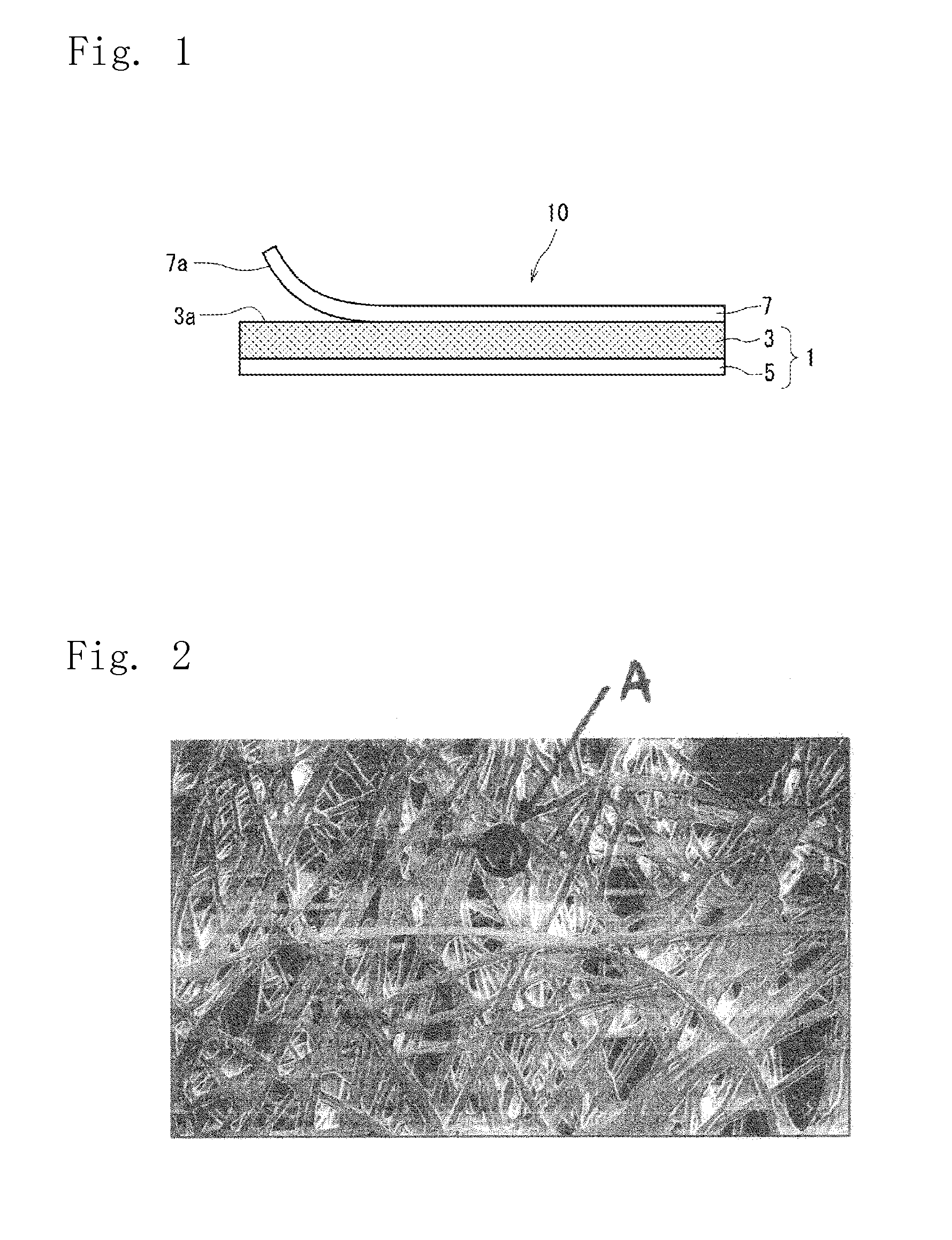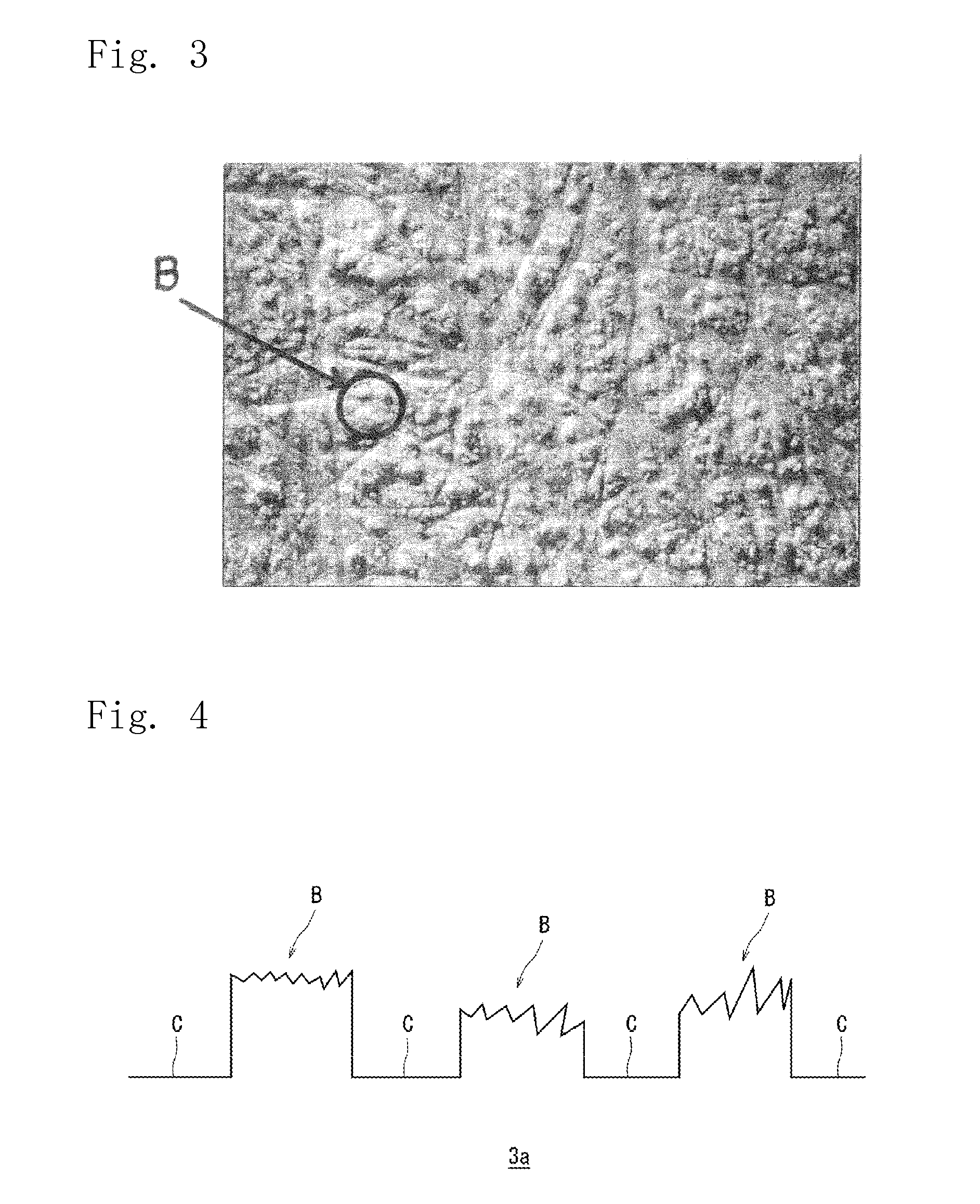Printing sheet and mold sheet for forming printing surface on the printing sheet
- Summary
- Abstract
- Description
- Claims
- Application Information
AI Technical Summary
Benefits of technology
Problems solved by technology
Method used
Image
Examples
examples
[0091]Excellent effects of the invention will now be described by way of Experiments.
[0092]First, described below are testing methods and materials used in the Experiments.
(1) Method of Measuring the Quantity of Dents or Protuberances in the Inorganic Solidified Matter Layer or in the Nonwoven Fabric:
[0093]By using an electron microscope (Quanta 200, Genesis 2000 manufactured by EFI Co.), the surface of the inorganic solidified matter layer or the nonwoven fabric was photographed as a digital image being magnified by 100 times. By using an image processing software (Pop Imaging 4.00 manufactured by
[0094]Digital Being Kids Co.), the obtained digital image data were converted into two values by the discrimination analysis method to clearly distinguish dents and protuberances from each other. By using the image measuring function of the image processing software, further, the total numbers and area ratio of the dents and protuberances were measured per a unit area.
(2) Weather-Proof Tes...
preparation examples 1 to 4
[0115]The nonwoven fabric α and the nonwoven fabric β were treated with a hot calendar to obtain mold sheets A to D shown in Table 1. The whole numbers of dents in the mold sheets per a unit area and the area ratios were measured according to the above-mentioned measuring methods. The results were as shown in Table 1.
TABLE 1WholeAreaNonwovennumberratiofabricHeatingofofMoldsheettemp.Thicknessdentsdentssheetused(° C.)(mm)per mm2(%)Moldnonwoven1250.10514020sheet Afabric αMoldnonwoven1350.10012718sheet Bfabric αMoldnonwoven1250.08019727sheet Cfabric βMoldnonwoven1350.07518323sheet Dfabric β
[0116]Next, 100 parts by weight of the slaked lime, 60 parts by weight of an aqueous emulsion of acrylic resin, 20 parts by weight of water and 5 parts by weight of a liquid-absorbing inorganic powder (fine alumina powder) were kneaded together to obtain a slurry of slaked lime. A pulp paper (300×300 mm) was used as the base sheet, and the above slurry of slaked lime was applied on the surface thereof...
preparation examples 5 and 6
[0121]90 Parts by weight of the slaked lime, 55 parts by weight of an aqueous emulsion of acrylic resin, 25 parts by weight of water and 10 parts by weight of inorganic powder (calcium carbonate) were kneaded together to obtain a slurry of slaked lime. Next, a glass fiber-mixed paper (500×500 mm) was used as the base sheet, and the above slurry of slaked lime was applied on the surface thereof by using a bar coater. Immediately thereafter, the mold sheets A and B shown in Table 1 obtained in Preparation Examples 1 and 2 were press-adhered onto the surface of the slurry and were dried in a drier heated at 70° C. for 10 minutes. The mold sheets closely adhered on the surfaces of the laminates were stripped off to find that no fiber was adhering on the surfaces. Next, the whole numbers of the protuberances on the surfaces of the inorganic solidified matter layers per a unit area and the area ratios were measured according to the above-mentioned methods. Further, the contents of the sla...
PUM
| Property | Measurement | Unit |
|---|---|---|
| Length | aaaaa | aaaaa |
| Diameter | aaaaa | aaaaa |
| Area | aaaaa | aaaaa |
Abstract
Description
Claims
Application Information
 Login to View More
Login to View More - R&D
- Intellectual Property
- Life Sciences
- Materials
- Tech Scout
- Unparalleled Data Quality
- Higher Quality Content
- 60% Fewer Hallucinations
Browse by: Latest US Patents, China's latest patents, Technical Efficacy Thesaurus, Application Domain, Technology Topic, Popular Technical Reports.
© 2025 PatSnap. All rights reserved.Legal|Privacy policy|Modern Slavery Act Transparency Statement|Sitemap|About US| Contact US: help@patsnap.com



